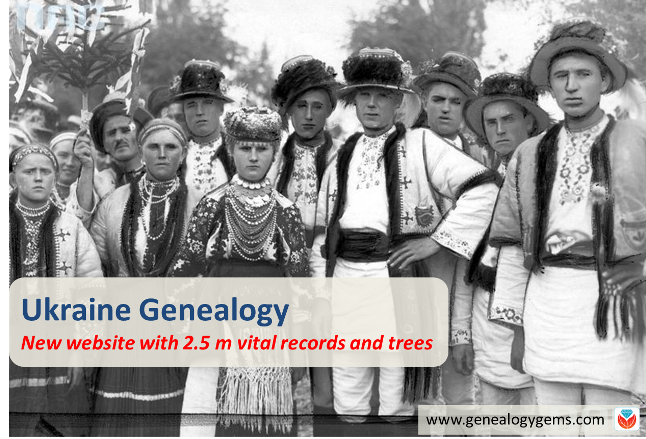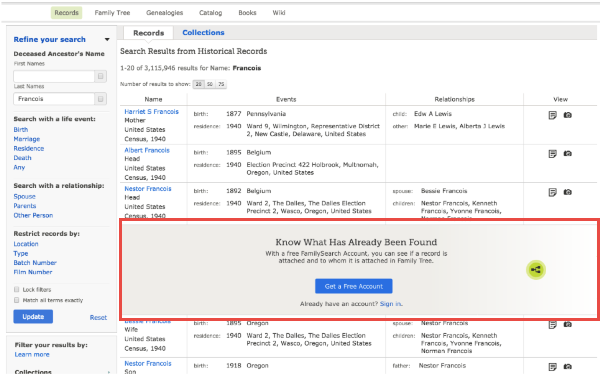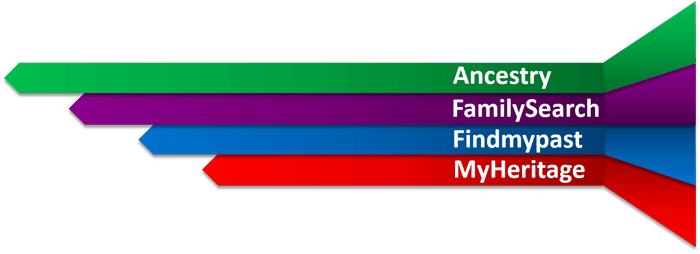NEW Ukraine Genealogy Website Tops List of New Genealogy Records Online
Read all about a new free Ukraine genealogy website, Yorkshire parish records, English workhouse records, German vital records and digitized newspaper coverage of England, Ireland and Scotland.

A New Ukraine Genealogy Website! Vital records and family trees
A new, free Ukraine genealogy website has launched with free family-tree building capability and an enormous database of nearly 300 years of genealogical records from present-day Ukraine. “The database includes 2.56 million people and is expected to reach 4 to 5 million in 2019,” reports EuroMaidan Press. “The access to its contents is and will remain free of charge. The sources of data are manifold: birth registers, fiscal and parish censuses, lists of nobility, voters, the military, and victims of repressions, address directories, and other documents produced under the Tsardom of Muscovy, Russian and Habsburg Empires, Poland and the Soviet Union. A Roman-letter version of the data index is reportedly to be enabled in the coming months.”

To translate the site, bring it up in Google Chrome and right-click.
The family tree-building feature has already proven incredibly popular, reports the same article: “nearly 18 thousand trees have been created in the first couple of days following the official inauguration of the site.” Automated tree-matching hinting will apparently be added in July 2017.
If you have Ukrainian roots, you may also want to read this article about how to request KGB files on relatives.
British Newspaper Archive: New content and free webinar!
The following historical newspaper coverage has been added to the British Newspaper Archive. They add about 100,000 pages every week–learn more about what they do in the free webinar, below.
- England.
- London: The Kilburn Times.
- Essex: The Southend Standard and Essex Weekly Advertiser from Southend-on-Sea.
- Hertfordshire: Watford Observer, for the town of Watford; added 1879-1886 to this paper’s coverage.
- Staffordshire: The Staffordshire Chronicle from the county town of Stafford.
- West Yorkshire: Wharfedale & Airdale Observer, published in Otley.
- Ireland. Londonderry: Northern Constitution/Coleraine Constitution (1888-1887).
- Scotland: Rothesay Chronicle, covering the Isle of Bute, Isle of Arran, and the mainland. Added coverage for 1884-1892.
More Irish newspapers: Findmypast has added 20th-century coverage of Dublin in the form of about 155,000 news articles from The Catholic Standard. (Limit your search to this paper by using the filters along the left side of the webpage.) The coverage includes weekly news reports dating from 1933-1949 and 1951-1957.
England
1861 workhouse inmates. Ancestry.com subscribers can now search indexed images of a new collection, England and Wales, Long-Term Workhouse Inmates, 1861. “This collection comprises records and images from a volume listing every adult ‘pauper’ in each Workhouse in England and Wales, who had been resident there for five or more years in 1861,” states the collection description. The report was in response to a government mandate to record long-term residents of workhouses. “The report was printed on 30 July 1861 and listed 14,216 adults,” continues the collection description. “When compared with the total workhouse population of approximately 67,800 adult workhouse inmates (excluding vagrants) the percentage of long term inmates was just over 21%.”
Yorkshire parish records. Findmypast has published these new church record collections for Yorkshire:
- Yorkshire Parish Registers and Bishop’s Transcripts. Over 11,000 browse-only volumes of baptisms, marriages, and deaths dating back to 1538.
- Yorkshire baptisms. Over 600,000 records have been added for Sheffield and the East Riding to this database, which now has more than 5 million entries.
- Yorkshire banns. Over 30,000 entries have been added for Sheffield and the East Riding.
- Yorkshire marriages. Over 400,000 entries have been added for Sheffield and the East Riding. The database now has nearly 3 million records.
- Yorkshire burials. Over half a million new burials have been added for Sheffield and the East Riding; this database now tops 4.7 million.
Germany: Church and civil records
Ancestry.com has a new browse-only collection of church records from 42 communities in Erfurt, the capital of Thuringia. According to a collection description, “The vast majority of the church records are from Protestant communities, but some Catholic and Jewish communities are also included. In one case, records from the ‘Kaufmannsgemeinde’ or merchants’ community are included.”
Also at Ancestry.com is a new collection of browse-only civil marriage records. Bischofswerda, Germany, Marriages, 1876-1922 includes government records of marriages from Bischofswerda and 11 other communities from the district of Bautzen; date ranges of records from each may vary.
Subscribe to the free weekly Genealogy Gems newsletter! You’ll stay up-to-date with the latest genealogy records online and genealogy news you want to know–like the recent announcement of the end of FamilySearch microfilm lending and RootsMagic’s new ability to sync with Ancestry.com.

Disclosure: This post contains affiliate links and Genealogy Gems will be compensated if you make a purchase after clicking on these links. Thank you for supporting Genealogy Gems!
7 Steps for Preserving Old Photo Albums and Scrapbooks
Preserving old albums means figuring out what to do with everything inside. What if items are dirty or mildewed? How can you safely store related memorabilia? The Archive Lady Melissa Barker tackles these common and important questions. Recently Donna wrote in to tell...African American Genealogy Records: New and Free!
Explore these African and African American genealogy records in celebration of your family history and Black History Month! Also this week: see new records online for Southern Claims Commission, GA, NY and VA as well as African heritage sites, Liberia and South...Why You Should Have a Free FamilySearch Account–And Use It!
A free FamilySearch account gives you access to more historical records and customized site features than you’ll see if you don’t log in at this free genealogy website. Here’s why you should get a free FamilySearch account and log in EVERY time you visit the site.

This post is part of our ongoing commitment to help you get the most out of the “Genealogy Giants:”
In this post, I comment on a recent announcement from the free giant everyone should be using: FamilySearch.org.
Why you should have (and use!) a free FamilySearch account
FamilySearch.org has always allowed free public use of its site. But beginning on December 13, 2017, the site will now actively prompt visitors to register for a free FamilySearch account or to log in with their existing accounts. Anyone can continue to search the catalog and user-submitted genealogies, explore over 350,000 digitized books, learn from the Wiki and the learning center, and even view user-contributed photos and stories. But by requesting you to log in, FamilySearch wants to remind you that this is your path to even more free records and services on the site.
Here are my top three reasons to have and use a free FamilySearch account:
1. Access more free historical records on FamilySearch.
We’ve talked a lot in recent months about best strategies for accessing digitized and off-line historical records at FamilySearch. Some of the digitized records on FamilySearch are there courtesy of a partner organization, which may restrict record access to those who log in on the site.
One woman had an “ah-ha” moment of realization after reading FamilySearch’s announcement. She posted in the comments, “Though I have had a free account for some time, I did not realize that FamilySearch was not giving me full access to information in record searches just because I had not logged in. Maybe I need to redo my past searches as a logged-in account holder.”
2. Participate in the global Family Tree.
As I more fully describe in my quick reference guide, Genealogy Giants: Comparing the 4 Major Websites, FamilySearch’s online family tree is different than the tree systems used at the other major family history websites. Instead of creating your own personal tree, you participate in a collaborative, unified family tree of the world. As a logged-in visitor, you can enter your information, then that of your parents and their parents, etc. until you connect to deceased individuals who are already on the tree. (Information about living individuals is always privacy-protected.) Then you may, with other descendants, contribute what you to know to an ancestor’s profile.
Anyone may make changes to these public profiles, which may at times be frustrating. But it also allows for more focused collaboration. This is a great place to see a virtual compilation of others’ research on particular ancestors without having to search others’ personal trees individually, as you do on other sites (remember to look for their source citations and verify what others say). The Family Tree on FamilySearch is also a great place to digitally archive family documents and photos where other researchers may see and appreciate them for free. As you can see in the screenshot below, logging in also helps you see how others have identified the folks you see in your search results:

3. Get customized help.
Those who log in with a free FamilySearch account have access to one-on-one assistance through the website. If you have a question about using the site, accessing records, finding additional records about your ancestors, or even how to understand the records you’re looking at, you can email or call a live support person for help. Your login also sets you up to receive customized alerts and seasonal messages (like “Did you know your ancestor fought in the War of 1812?”) and a dashboard experience with at-a-glance reminders of record hints awaiting your review, where you left off in your last online session, tips about what to do next, and more. Here’s what the dashboard looks like:

How to get (or recover) a free FamilySearch account
See Registering to use FamilySearch.org for information about creating a free account. FamilySearch accounts have always been free and, the site assures us, will continue to be free. You will need to provide your first and last name, a username, a password, and an email or mobile phone number.
According to FamilySearch, your login and other personal information:
- enables collaboration in the Family Tree and Memories areas of the site (you control how much information is shared)
- “allows you to send in-system messages to other users without revealing your personal identity or email address”
- “allows FamilySearch to send you emails and newsletters (you can specify how many emails, if any, you receive)”
- enables communication when you contact their online support team for help
- will not be shared “with any third party without your consent”
If you’ve already got a FamilySearch account but have forgotten your username, click here. If you’ve forgotten your password, click here.
Genealogy Gems Brings You Genealogy Giants
 Each of the “Genealogy Giants” has so much to offer family historians around the world! But it’s hard to keep them straight, compare their top features, and get the most out of them without some inside help. That’s why we published the must-have quick reference guide, Genealogy Giants: Comparing the 4 Major Websites, your personal comparative tour of Ancestry.com, FamilySearch, Findmypast, and MyHeritage.
Each of the “Genealogy Giants” has so much to offer family historians around the world! But it’s hard to keep them straight, compare their top features, and get the most out of them without some inside help. That’s why we published the must-have quick reference guide, Genealogy Giants: Comparing the 4 Major Websites, your personal comparative tour of Ancestry.com, FamilySearch, Findmypast, and MyHeritage.
This inexpensive guide can save you hours of wasted time hunting down the records you need. It can save you hundreds of dollars by helping you invest in the genealogy websites you most need to use right now–because your research needs change right along with your growing family tree! The guide is available for your immediate reference as a digital download or get a handy, high-quality printed copy you can keep with your genealogy research files.

